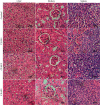Toxicological Evaluation of Camellia euphlebia Leaves Aqueous Extract Using Acute and Subacute Toxicity Studies in Mice and Genotoxicity Studies
- PMID: 35211181
- PMCID: PMC8863466
- DOI: 10.1155/2022/7889199
Toxicological Evaluation of Camellia euphlebia Leaves Aqueous Extract Using Acute and Subacute Toxicity Studies in Mice and Genotoxicity Studies
Abstract
Camelliaeuphlebia is a novel food source and Chinese folk medicine with multiple pharmacological properties. Our previous exploration has demonstrated the antidepressant-like activity of Camellia euphlebia leaves aqueous extract by reliable animal models of depression; however, a lack of toxicological information limits its pharmacological application. The present study aimed to evaluate the preliminary safety of C. euphlebia extract by determining acute/subacute toxicity in mice and in vivo/in vitro genotoxicity. The oral-medium lethal dose of the extract in mice was found to be higher than 5000 mg/kg body weight in the acute toxicity study. In a 14-days subacute toxicity study, C. euphlebia extract at doses of 400, 800, and 1600 mg/kg did not result in significant changes in food intake, water intake, body weight, relative organ weight, aspartate aminotransferase activity, alanine aminotransferase activity, creatinine level, and number of white blood cells and red blood cells. However, histopathology observation of organs taken from all mice showed that 1600 mg/kg extract caused slight hydropic degeneration in the cytoplasm of hepatocytes. In a 28-days subacute toxicity study, 600 mg/kg extract significantly increased the level of red blood cells but produced no negative side effects on other pathological parameters. Mice treated with the extract at doses of 200, 400, and 600 mg/kg for 28 days did not manifest any histopathological alterations of the liver, kidney, and spleen. Additionally, the extract showed no chromosomal aberrations in the in vivo micronucleus test and in vitro chromosomal aberration test. The results revealed that the extract showed no significant toxic effects and no potential genotoxicity but with the likelihood of transient erythrocytosis and slight hepatotoxicity. Further chronic toxicological evaluation involved in more physiological parameters, especially associated with liver toxicity and erythropoietin level, would be needed to determine its safety and application value.
Copyright © 2022 Dongye He and Yongping Xu.
Conflict of interest statement
The authors declare that there are no conflicts of interest regarding the publication of this paper.
Figures





Similar articles
-
Camellia euphlebia exerts its antidepressant-like effect via modulation of the hypothalamic-pituitary-adrenal axis and brain monoaminergic systems.Metab Brain Dis. 2018 Feb;33(1):301-312. doi: 10.1007/s11011-017-0167-1. Epub 2017 Dec 16. Metab Brain Dis. 2018. PMID: 29247282
-
Evaluation of the Anxiolytic and Antidepressant Activities of the Aqueous Extract from Camellia euphlebia Merr. ex Sealy in Mice.Evid Based Complement Alternat Med. 2015;2015:618409. doi: 10.1155/2015/618409. Epub 2015 Nov 1. Evid Based Complement Alternat Med. 2015. PMID: 26579203 Free PMC article.
-
Safety evaluation of mulberry leaf extract: Acute, subacute toxicity and genotoxicity studies.Regul Toxicol Pharmacol. 2018 Jun;95:220-226. doi: 10.1016/j.yrtph.2018.03.007. Epub 2018 Mar 9. Regul Toxicol Pharmacol. 2018. PMID: 29530616
-
Final report on the safety assessment of capsicum annuum extract, capsicum annuum fruit extract, capsicum annuum resin, capsicum annuum fruit powder, capsicum frutescens fruit, capsicum frutescens fruit extract, capsicum frutescens resin, and capsaicin.Int J Toxicol. 2007;26 Suppl 1:3-106. doi: 10.1080/10915810601163939. Int J Toxicol. 2007. PMID: 17365137 Review.
-
Safety and nutritional assessment of GM plants and derived food and feed: the role of animal feeding trials.Food Chem Toxicol. 2008 Mar;46 Suppl 1:S2-70. doi: 10.1016/j.fct.2008.02.008. Epub 2008 Feb 13. Food Chem Toxicol. 2008. PMID: 18328408 Review.
Cited by
-
Preparation, Antioxidant Activities and Bioactive Components of Kombucha Beverages from Golden-Flower Tea (Camellia petelotii) and Honeysuckle-Flower Tea (Lonicera japonica).Foods. 2023 Aug 10;12(16):3010. doi: 10.3390/foods12163010. Foods. 2023. PMID: 37628009 Free PMC article.
References
-
- Oliveira A. M. d., Nascimento M. F. d., Ferreira M. R. A., et al. Evaluation of acute toxicity, genotoxicity and inhibitory effect on acute inflammation of an ethanol extract of Morus alba L. (Moraceae) in mice. Journal of Ethnopharmacology . 2016;194:162–168. doi: 10.1016/j.jep.2016.09.004. - DOI - PubMed
-
- Guo J. Five kinds of items listed as new members in source of food catalogue. Farm Products Processing . 2010;6:p. 39.
LinkOut - more resources
Full Text Sources

